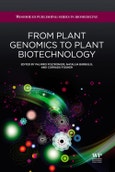This book covers these issues, showing how such technologies are influencing the plant field in sectors such as the selection of plant varieties and plant breeding, selection of optimum agronomic traits, stress-resistant varieties, improvement of plant fitness, improving crop yield, and non-food applications in the knowledge based bio-economy.
Table of Contents
List of figures
List of tables
Abbreviations
About the contributors
Introduction
Chapter 1: From plant genomics to -omics technologies
Abstract:
1.1 SuperSAGE
1.2 CAGE cap analysis of gene expression
1.3 -Omics and new advances in plant functional genomics
Chapter 2: Plant microRNAs
Abstract:
2.1 Introduction
2.2 Transcription of miRNA genes
2.3 MicroRNA processing
2.4 Modes of action
2.5 Evolution of miRNA genes
2.6 Differences from animal miRNAs
2.7 miRNA functions
2.8 The potential roles of microRNAs in crop improvement
Chapter 3: Epigenetic control by plant Polycomb proteins: new perspectives and emerging roles in stress response
Abstract:
3.1 Introduction
3.2 Conserved multi-protein complexes with histone post-translational modifying activities
3.3 Polycomb functions in plant development
3.4 Non-coding RNAs as regulatory cofactors of Polycomb complexes
3.5 Emerging roles of PcG and ncRNAs in responses to environmental stress
3.6 PcG protein functions in three-dimensional nuclear organization
3.7 Perspectives: the role of Polycomb in abiotic and biotic stress response
Chapter 4: Metabolite profiling for plant research
Abstract:
4.1 Introduction
4.2 Methodological approach
4.3 Metabolomic platform
4.4 Metabolomics in plant science
4.5 The future role of metabolomics in crop improvement
4.6 Conclusion
Chapter 5: The uniqueness of conifers
Abstract:
5.1 Introduction
5.2 Functional differentiation
5.3 Genome structure and composition
5.4 Genome function
5.5 Chemical divergence
5.6 Meeting the challenge: the system biology approach to unraveling the conifer genome
Chapter 6: Cryptochrome genes modulate global transcriptome of tomato
Abstract:
6.1 Introduction
6.2 Cryptochrome functions
6.3 Role of cryptochromes in mediating light-regulated gene expression in plants
6.4 Cryptochromes influence the diurnal global transcription profiles in tomato
Chapter 7: Genomics of grapevine: from genomics research on model plants to crops and from science to grapevine breeding
Abstract:
7.1 Use of genetic and molecular markers for studies of genetic diversity and genome selection in grapevine
7.2 Grapevine breeding
7.3 Transgene silencing
7.4 Identification and characterization of transgene insertion loci
7.5 Integration of vector backbone
7.6 Stability of inserted transgenes
7.7 Conclusions
7.8 Acknowledgement
Chapter 8: Grapevine genomics and phenotypic diversity of bud sports, varieties and wild relatives
Abstract:
8.1 Introduction
8.2 Origin of Vitis vinifera, domestication, and early selection for fruit characters
8.3 Sources of phenotypic variation in present-day grapevines
8.4 Genomic tools in the genome sequencing era
8.5 Current activities in grapevine genome analysis
8.6 Bud organogenesis, somatic mutations, and DNA typing of somatic chimeras
8.7 Phenotypically divergent clones and the underlying DNA variation
8.8 Transposon insertion-site profiling using NGS
8.9 Large structural variation using NGS
8.10 Copy number variation, gene redundancy, and subtle specialisation in secondary metabolism
8.11 Conclusions
Chapter 9: Peach ripening transcriptomics unveils new and unexpected targets for the improvement of drupe quality
Abstract:
9.1 Introduction
9.2 The fruit
9.3 Peach development and ripening
9.4 Microarray Transcript Profiling in peach
9.5 New players in the control of peach ripening
9.6 Conclusions
9.7 Acknowledgements
Chapter 10: Application of doubled haploid technology in breeding of Brassica napus
Abstract:
10.1 Introduction
10.2 Technique of isolated microspore culture
10.3 Doubled haploid method in breeding of Brassica napus
10.4 In vitro mutagenesis
10.5 Utilization of double haploidy in selection for resistance
10.6 Selection for modified seed oil composition
10.7 Selection for improved seed meal
10.8 Selection for cold tolerance
10.9 Concluding remarks
Chapter 11: Plant biodiversity and biotechnology
Abstract:
11.1 Biodiversity
11.2 Biotechnology
11.3 Heat stress tolerance in cereals
11.4 Modern approaches in cereals for yield and food security under temperature stress
11.5 Future perspectives
11.6 Acknowledgment
Chapter 12: Natural resveratrol bioproduction
Abstract:
12.1 Stilbenes and resveratrol
12.2 Health benefits of resveratrol
12.3 trans-resveratrol production through plant cell cultures
12.4 Introducing new pathway branches to crop plants: trans-resveratrol synthesis in tomato fruits
12.5 Concluding remarks
Index








